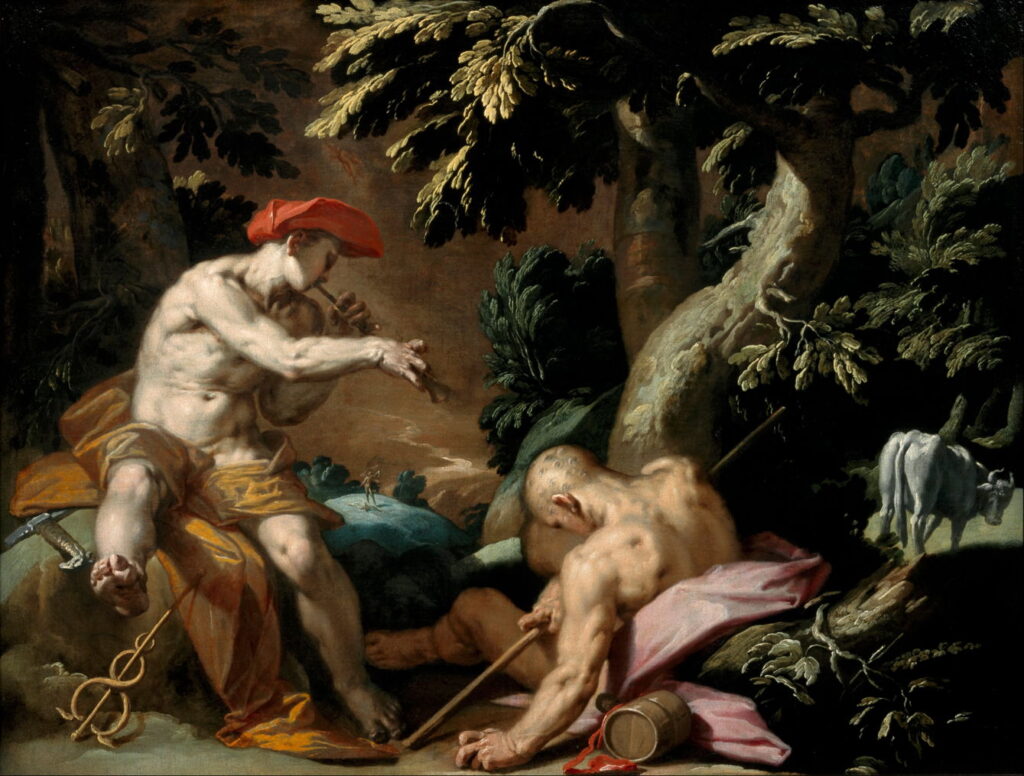Reading visual art: 132 Aulos, pipe or flute

According to Greek mythology, the goddess Athena invented a musical instrument consisting of a double pipe with reeds, named the aulos (αὐλός), and related to the modern oboe or bagpipes. When the other gods made fun of her puffing out her cheeks to play her new instrument, she tossed it aside, only for the satyr Marsyas to discover it. In time, the satyr became highly proficient in playing it, and in a rash moment ended up in an impossible musical contest with Apollo, which he inevitably lost, and was flayed alive as his penalty.
Elihu Vedder (1836–1923), Young Marsyas (Marsyas Enchanting the Hares) (1878), oil on canvas, dimensions not known, Private collection. The Athenaeum.
Late in 1877, the wife of the artist Elihu Vedder recorded in a letter that her husband had been thinking about Marsyas, and considered that, before his contest with Apollo, Marsyas must have proved his skill with the aulos. He therefore came up with the idea that this must have at least been through charming hares with the instrument. Vedder started this painting early in 1878, and set it in the New England winter.
Giovanni Battista Tiepolo (1696–1770), Apollo and Marsyas (1720-22), oil on canvas, 100 x 135 cm, Gallerie dell’Accademia, Venice. Wikimedia Commons.
Tiepolo’s Apollo and Marsyas from 1720-22 takes the contest as its theme. It’s easy here to mistake the figure sat on the rock throne as being Apollo, but he is actually the youth at the left, bearing his lyre, wearing a wreath of laurel, and given a gentle divine halo.
Thus the figure apparently wearing a gold crown sat in a dominant position must be Marsyas, clutching a flute of sorts rather than a proper aulos, in his right hand. To the right are some of the Muses, one of whom covers her eyes in despair. She knows what Apollo’s pointing arm is about to inflict on the usurper Marsyas.
Hans Thoma (1839–1924), Apollo and Marsyas (1886), oil on panel, 45 × 55 cm, location not known. Wikimedia Commons.
Apollo and Marsyas (1886) is Hans Thoma’s depiction of this myth. He chooses to show the contest itself, with Marsyas playing, and only three of the Muses in the background.
The Sirens have also been depicted as playing the aulos in their efforts to lure mariners to their death.
William Etty (1787–1849), The Sirens and Ulysses (c 1837), oil on canvas, 297 x 442.5 cm, Manchester Art Gallery, Manchester, England. Wikimedia Commons.
William Etty’s The Sirens and Ulysses from about 1837 is one of the pioneering accounts in paint of this story from the Odyssey. His three naked sirens are all woman, one playing a lyre, another holding double pipes aloft, all three doing their best to draw the sailors from Odysseus’ ship to a shore on which lie the remains of earlier victims.
Arnold Böcklin (1827–1901), Sirens (1875), tempera on canvas, 46 × 31 cm, Alte Nationalgalerie, Berlin. Wikimedia Commons.
Arnold Böcklin takes an unusual approach of almost dereferencing Odysseus in this painting of Sirens from 1875, although there is an approaching vessel which could be his. The two Sirens filling the canvas are very human down to the waist, below which they resemble birds. One sits facing us, clearly in full voice, and very alluring in looks. The other, her back towards us, is playing an aulos and looks rather obese, to the point of almost being comical, her right breast laid upon a flat-topped rock. At their feet are three human skulls and other bones to indicate their graver intentions.
Henrietta Rae (1859–1928), The Sirens (1903), oil on canvas, 114.3 × 254 cm, Private collection. Wikimedia Commons.
The Sirens (1903) marked Henrietta Rae’s return to painting narrative works featuring classical nudes. Odysseus’ ship is in the distance, as three beautiful Sirens use their aulos and lyre to lure its occupants.
Ovid’s retelling of the myth of Io, who was turned into a cow then watched over by Argus, inserts the myth of Syrinx in the midst of the story. For most artists, that has led them to paint Mercury trying to send Argus to sleep by playing his reed pipes, but two notable depictions opt for Mercury playing the aulos instead.
Bartolomeo di Giovanni (1480-1510), The Myth of Io (c 1490), tempera and oil on wood panel, 65 x 171.5 cm, Walters Art Museum, Baltimore, MD. Wikimedia Commons.
Bartolomeo di Giovanni’s panel The Myth of Io from about 1490 is believed to have had a companion telling the first part of the story using a similar multiplex narrative technique. The surviving panel tells the second part, after Io has been transformed into a cow. At the left, Jupiter (in the clouds) directs Mercury (carrying his caduceus) to free Io the cow from the watchful eyes of Argus (shown with a red cloak). Mercury takes a flock up the hill to Argus, where he sits with Argus and puts him to sleep while playing his aulos. Once asleep (centre), Mercury beheads Argus, and gives Juno his head to place its eyes on her peacocks (bottom centre).
Abraham Bloemaert (1564–1651), Mercury, Argus and Io (c 1592), oil, 63.5 x 81.3 cm, Centraal Museum, Utrecht, The Netherlands. Wikimedia Commons.
Abraham Bloemaert is one of the few painters who has attempted to show Argus’s hundred eyes, in his carefully composed Mercury, Argus and Io from about 1592. Mercury is playing his aulos at the left, as Argus falls asleep in front of him, his additional eyes visible over the surface of his head. In the distance at the right is Io as a white cow.
Jean-Léon Gérôme (1824–1904), Anacreon, Bacchus, and Amor (1848), oil on canvas, 135.9 x 211.1 cm, Musée des Augustins, Toulouse, France. The Athenaeum.
Finally, Jean-Léon Gérôme’s early painting of Anacreon, Bacchus, and Amor from 1848 harks back to the secret rites of bacchantes invoking Anacreon, one of the nine canonical Greek lyric poets. The poet takes centre stage with his lyre at his shoulder. Dancing at his feet is the infant Bacchus, who looks to the left at a young woman playing the double pipes. To the right of Anacreon is Cupid (Amor), with his wings, bow, and quiver of arrows.



